Structural Heterogeneity of Biochar Modulates’ Soil Hydraulic Properties and Nutrient Migration
Abstract
1. Introduction
2. Materials and Methods
2.1. Materials for Biochar Preparation
2.2. Experimental Design
2.3. Measurement Indicators and Methods
2.3.1. Apparent Morphological Analysis of Biochar and Soil Mixed Matrix Particles
2.3.2. Characterization of Soil Pore Structure
2.3.3. Contact Angle Determination of the Hydrophilicity and Hydrophobicity of Homogeneous Carbonaceous Soils
2.3.4. Methods of Testing
2.3.5. Soil Infiltration Modeling
2.3.6. Convective Dispersion Equation Fitting
2.4. Data Processing and Analysis
3. Results and Analysis
3.1. Apparent Properties of Biochars and Mixed Substrates
3.2. Effect of the Structural Heterogeneity of Biochar on the Pore Structure Parameters of Biochar–Soil Hybrid Substrates
3.3. Effect of the Structural Heterogeneity of Biochar on the Water Repellency of Soil and the Surface Energy of the Solids
3.4. Effect of the Structural Heterogeneity of Biochar on Soil’s Hydraulic Parameters
3.5. Effect of the Structural Heterogeneity of Biochar on Soil’s Infiltration Properties
3.6. Effect of Biochar’s Structural Heterogeneity on Soil’s Solute Penetration
3.7. Mantel Test and Pearson Correlation Analysis
4. Discussion
4.1. Effect of the Structural Heterogeneity of Biochar on Soil’s Pore Structure
4.2. Effect of Biochar’s Heterostructural Texture on Soil’s Hydraulic Properties
4.3. Effects of the Structural Heterogeneity of Biochar on Soil Infiltration
4.4. Effect of the Structural Heterogeneity of Biochar on Soil’s Solute Penetration
5. Conclusions
Author Contributions
Funding
Data Availability Statement
Conflicts of Interest
References
- Ju, X.; She, D.; Huang, X.; Xia, Y.; Gao, L. Characterization and prediction of soil hydraulic and solute transport parameters using a random forest model. Eur. J. Soil Sci. 2024, 75, 13471. [Google Scholar] [CrossRef]
- Sombroek, W. Spatial and Temporal Patterns of Amazon Rainfall. AMBIO J. Hum. Environ. 2001, 30, 388–396. [Google Scholar] [CrossRef]
- Feng, Z.; Nie, W.; Ma, Y.; Li, Y.; Ma, X.; Zhu, H. Effects of urea solution concentration on soil hydraulic properties and water infiltration capacity. Sci. Total Environ. 2023, 898, 165471. [Google Scholar] [CrossRef]
- Verheijen, F.G.A.; Zhuravel, A.; Silva, F.C.; Amaro, A.; Ben-Hur, M.; Keizer, J.J. The influence of biochar particle size and concentration on bulk density and maximum water holding capacity of sandy vs sandy loam soil in a column experiment. Geoderma 2019, 347, 194–202. [Google Scholar] [CrossRef]
- Yang, C.; Lu, S. Effects of five different biochars on aggregation, water retention and mechanical properties of paddy soil: A field experiment of three-season crops. Soil Tillage Res. 2021, 205, 104798. [Google Scholar] [CrossRef]
- Razzaghi, F.; Obour, P.; Arthur, E. Does biochar improve soil water retention? a systematic review and meta-analysis. Geoderma 2020, 361, 114055. [Google Scholar] [CrossRef]
- Gloria, I.; Ondřej, M. The role of biochar particle size and hydrophobicity in improving soil hydraulic properties. Eur. J. Soil Sci. 2022, 73, 13138. [Google Scholar] [CrossRef]
- Zanutel, M.; Garré, S.; Sanglier, P.; Bielders, C. Biochar modifies soil physical properties mostly through changes in soil structure rather than through its internal porosity. Vadose Zone J. 2023, 23, e20301. [Google Scholar] [CrossRef]
- Wang, K.; Zhang, X.; Sun, C.; Yang, K.; Zheng, J.; Zhou, J. Biochar application alters soil structure but not soil hydraulic conductivity of an expansive clayey soil under field conditions. J. Soils Sediments 2021, 21, 73–82. [Google Scholar] [CrossRef]
- Rabbi, S.; Minasny, B.; Salami, S.; McBratney, A.; Young, I. Greater, but not necessarily better: The influence of biochar on soil hydraulic properties. Eur. J. Soil Sci. 2021, 72, 2033–2048. [Google Scholar] [CrossRef]
- Chandra, S.; Bhattacharya, J. Influence of temperature and duration of pyrolysis on the property heterogeneity of rice straw biochar and optimization of pyrolysis conditions for its application in soils. J. Clean. Prod. 2019, 215, 1123–1139. [Google Scholar] [CrossRef]
- Edeh, I.G.; Masek, O.; Buss, W. A meta-analysis on biochar’s effects on soil water properties—New insights and future research challenges. Sci. Total Environ. 2020, 714, 136857. [Google Scholar] [CrossRef]
- Alghamdi, A.; Alkhasha, A.; Ibrahim, H. Effect of biochar particle size on water retention and availability in a sandy loam soil. J. Saudi Chem. Soc. 2020, 24, 1042–1050. [Google Scholar] [CrossRef]
- Esmaeelnejad, L.; Shorafa, M.; Gorji, M.; Hosseini, S. Impacts of woody biochar particle size on porosity and hydraulic conductivity of biochar-soil mixtures: An incubation study. Commun. Soil Sci. Plant Anal. 2017, 48, 1710–1718. [Google Scholar] [CrossRef]
- Lim, T.; Spokas, K.; Feyereisen, G.; Novak, J. Predicting the impact of biochar additions on soil hydraulic properties. Chemosphere 2016, 142, 136–144. [Google Scholar] [CrossRef]
- Chandi, K.; Udomkun, P.; Boonupara, T.; Kaewlom, P. Enhancing soil health, microbial count, and hydrophilic methomyl and hydrophobic lambda-cyhalothrin remediation with biochar and nano-biochar. Sci. Rep. 2024, 14, 19551. [Google Scholar] [CrossRef]
- Mohanasundaram, S.; Kumar, S.; Nagabhooshanam, N.; Sharma, K.; Rao, P.; Pravallika, V.; Shankar, M. Electromagnetic interference shielding and mechanical and hydrophobic properties of papaya peel biocarbon and banana fiber–reinforced epoxy composite: Synthesize and Characterization. Biomass Convers. Biorefin. 2024, 15, 12689–12698. [Google Scholar] [CrossRef]
- Daraei, E.; Bayat, H.; Gregory, S. Impact of natural biochar on soil water retention capacity and quinoa plant growth in different soil textures. Soil Tillage Res. 2024, 244, 106281. [Google Scholar] [CrossRef]
- Fahmi, A.; Samsuri, A.; Jol, H.; Singh, D. Physical modification of biochar to expose the inner pores and their functional groups to enhance lead adsorption. RSC Adv. 2018, 8, 38270–38280. [Google Scholar] [CrossRef] [PubMed]
- Chen, X.; Duan, M.; Zhou, B.; Cui, L. Effects of biochar nanoparticles as a soil amendment on the structure and hydraulic characteristics of a sandy loam soil. Soil Use Manag. 2021, 38, 836–849. [Google Scholar] [CrossRef]
- Chen, Z.; Chen, C.; Kamchoom, V.; Chen, R. Gas permeability and water retention of a repacked silty sand amended with different particle sizes of peanut shell biochar. Soil Sci. Soc. Am. J. 2020, 84, 1630–1641. [Google Scholar] [CrossRef]
- Song, B.; Chen, M.; Zhao, L.; Qiu, H.; Cao, X. Physicochemical property and colloidal stability of micron- and nanoparticle biochar derived from a variety of feedstock sources. Sci. Total Environ. 2019, 661, 685–695. [Google Scholar] [CrossRef] [PubMed]
- Melo, L.; Lehmann, J.; Carneiro, J.; Camps-Arbestain, M. Biochar-based fertilizer effects on crop productivity: A meta-analysis. Plant Soil 2022, 472, 45–58. [Google Scholar] [CrossRef]
- Tian, L.; Shao, G.; Gao, Y.; Song, E.; Lu, J. Effects of Biochar on Soil Organic Carbon in Relation to Soil Nutrient Contents, Climate Zones and Cropping Systems: A Chinese Meta-Analysis. Land 2024, 13, 1608. [Google Scholar] [CrossRef]
- Wu, B.; Yang, H.; Li, S.; Tao, J. The effect of biochar on crop productivity and soil salinity and its dependence on experimental conditions in salt-affected soils: A meta-analysis. Carbon Res. 2024, 3, 56. [Google Scholar] [CrossRef]
- Oppong Danso, E.; Monnie, F.; Abenney-Mickson, S.; Arthur, E.; Sabi, E.; Andersen, M. Does Biochar Particle Size, Application Rate and Irrigation Regime Interact to Affect Soil Water Holding Capacity, Maize Growth and Nutrient Uptake? J. Soil Sci. Plant Nutr. 2021, 21, 3180–3193. [Google Scholar] [CrossRef]
- Vadakkan, K.; Sathishkumar, K.; Raphael, R.; Mapranathukaran, V.O.; Mathew, J.; Jose, B. Review on biochar as a sustainable green resource for the rehabilitation of petroleum hydrocarbon-contaminated soil. Sci. Total Environ. 2024, 941, 173679. [Google Scholar] [CrossRef]
- GB 7172-1987; Method for the Determination of Soil Water Content. China Standard Publishing House: Beijing, China, 1989.
- Bao, S. Soil and Agricultural Chemistry Analysis; China Agriculture Press: Beijing, China, 2000. [Google Scholar]
- Toride, N.; Leijand, F.J.; Van Genuchten, M.T. The CXTFIT Code for Estimating Transport Parameters from Laboratory or Field Tracer Experiments; U.S. Salinity Laboratory, USDA, ARS: Riverside, CA, USA, 1995; Volume 131, pp. 181–189. [Google Scholar]
- Zhang, W.; Meng, J.; Huang, Y.; Sarkar, B.; Singh, B.; Zhou, X.; Gao, J.; Teng, Y.; Wang, H.; Chen, W. Effects of soil grain size and solution chemistry on the transport of biochar nanoparticles. Front. Environ. Sci. 2023, 10, 1114940. [Google Scholar] [CrossRef]
- Yu, X.; Lu, S. Double effects of biochar in affecting the macropore systemof paddy soils identified by high-resolution X-ray tomography. Sci. Total Environ. 2020, 720, 137690. [Google Scholar] [CrossRef]
- Ouyang, L.; Wang, F.; Tang, J.; Yu, L.; Zhang, R. Effects of biochar amendment on soil aggregates and hydraulic properties. J. Soil Sci. Plant Nutr. 2013, 13, 991–1002. [Google Scholar] [CrossRef]
- Stewart, M.L.; Ward, A.L.; Rector, D. A study of pore geometry effects on anisotropy in hydraulic permeability using the lattice-Boltzmann method. Adv. Water Resour. 2005, 9, 1328–1340. [Google Scholar] [CrossRef]
- Petersen, C.; Hansen, E.; Larsen, H.; Hansen, L.; Ahrenfeldt, J.; Hauggaard-Nielsen, H. Pore-size distribution and compressi-bility of coarse sandy subsoil with added biochar. Eur. J. Soil Sci. 2016, 67, 726–736. [Google Scholar] [CrossRef]
- Acharya, B.S.; Dodla, S.; Wang, J.; Pavuluri, K.; Darapuneni, M.; Dattamudi, S.; Kharel, G. Biochar impacts on soil water dynamics: Knowns, unknowns, and research directions. Biochar 2024, 6, 34. [Google Scholar] [CrossRef]
- Sun, X.; She, D.; Fei, Y.; Wang, H.; Gao, L. Three-dimensional fractal characteristics of soil pore structure and their relationships with hydraulic parameters in biochar-amended saline soil. Soil Tillage Res. 2021, 205, 104809. [Google Scholar] [CrossRef]
- Lucia, T.; Dušan, I.; Ján, H.; Aydin, E. Can application of biochar improve the soil water characteristics of silty loam soil? J. Soils Sediments 2023, 23, 2832–2847. [Google Scholar] [CrossRef]
- Albalasmeh, A.; Quzaih, M.; Gharaibeh, M.; Rusan, M.; Mohawesh, O.; Rababah, S.; Alqudah, A.; Alghamdi, A.; Naserin, A. Significance of pyrolytic temperature, application rate and incubation period of biochar in improving hydro-physical properties of calcareous sandy loam soil. Sci. Rep. 2024, 14, 7012. [Google Scholar] [CrossRef]
- Garg, A.; Zhu, H.; Sarmah, A.K.; Mei, G.; Gadi, V. Evaluating mechanism and inconsistencies in hydraulic conductivity of unsaturated soil using newly proposed biochar conductivity factor. Biochar 2023, 5, 34. [Google Scholar] [CrossRef]
- Yang, X.; Fan, H.; Du, Y.; Zhang, L. Effect of biochar application on physicochemical and hydraulic properties of Loess. Adv. Civ. Eng. 2020, 2020, 4592092. [Google Scholar] [CrossRef]
- Abel, S.; Peters, A.; Trinks, S.; Schonsky, H.; Facklam, M.; Wessolek, G. Impact of biochar and hydrochar addition on water retention and water repellency of sandy soil. Geoderma 2013, 202, 183–191. [Google Scholar] [CrossRef]
- Chen, X.; Liu, L.; Yang, Q.; Xu, H.; Shen, G.; Chen, G. Optimizing Biochar Application Rates to Improve Soil Properties and Crop Growth in Saline–Alkali Soil. Sustainability 2024, 16, 2523. [Google Scholar] [CrossRef]
- Wang, H.; Shao, D.; Ji, B.; Gu, W.; Yao, M. Biochar effects on soil properties, water movement and irrigation water use efficiency of cultivated land in Qinghai-Tibet Plateau. Sci. Total Environ. 2022, 829, 154520. [Google Scholar] [CrossRef]
- Zou, Y.; Zhang, S.; Shi, Z.; Zhou, H.; Zheng, H.; Hu, J.; Jia, J. Effects of mixed-based biochar on water infiltration and evaporation in aeolian sand soil. J. Arid Land 2022, 14, 374–389. [Google Scholar] [CrossRef]
- Ramezanzadeh, H.; Zarehaghi, D.; Baybordi, A.; Bouket, A.C.; Oszako, T.; Alenezi, F.N.; Belbahri, L. The impacts of biochar-assisted factors on the hydrophysical characteristics of amended soils: A review. Sustainability 2023, 15, 8700. [Google Scholar] [CrossRef]
- Eibisch, N.; Durner, W.; Bechtold, M.; Fuß, R.; Mikutta, R.; Woche, S.K.; Helfrich, M. Does water repellency of pyrochars and hydrochars counter their positive effects on soil hydraulic properties? Geoderma 2015, 245, 31–39. [Google Scholar] [CrossRef]
- Fu, G.; Qiu, X.; Xu, X.; Zhang, W.; Zang, F.; Zhao, C. The role of biochar particle size and application rate in promoting the hydraulic and physical properties of sandy desert soil. CATENA 2021, 207, 105607. [Google Scholar] [CrossRef]
- Duan, Z.; Li, Z.; Wu, Y.; Niu, B.; Shen, R. Mechanical and microscopic properties of soil according to the rate of increase in pore water pressure. Soil Tillage Res. 2023, 225, 105530. [Google Scholar] [CrossRef]
- Awedat, A.M.; Zhu, Y.; Bennett, J.M.; Raine, S.R. The impact of clay dispersion and migration on soil hydraulic conductivity and pore networks. Geoderma 2021, 404, 115297. [Google Scholar] [CrossRef]
- Alkharabsheh, H.M.; Seleiman, M.F.; Battaglia, M.L.; Shami, A.; Jalal, R.S.; Alhammad, B.A.; Almutairi, K.F.; Al-Saif, A.M. Biochar and its broad impacts in soil quality and fertility, nutrient leaching and crop productivity: A review. Agronomy 2021, 11, 993. [Google Scholar] [CrossRef]
- Lowe, M.A.; McGrath, G.; Leopold, M. The impact of soil water repellency and slope upon runoff and erosion. Soil Tillage Res. 2021, 205, 104756. [Google Scholar] [CrossRef]
- Izaditame, F.; LeMonte, J.J.; Siebecker, M.G.; Yu, X.; Fischel, M.; Tappero, R.; Sparks, D.L. Sea-level rise and arsenic-rich soils: A toxic relationship. J. Hazard. Mater. 2024, 472, 134528. [Google Scholar] [CrossRef]
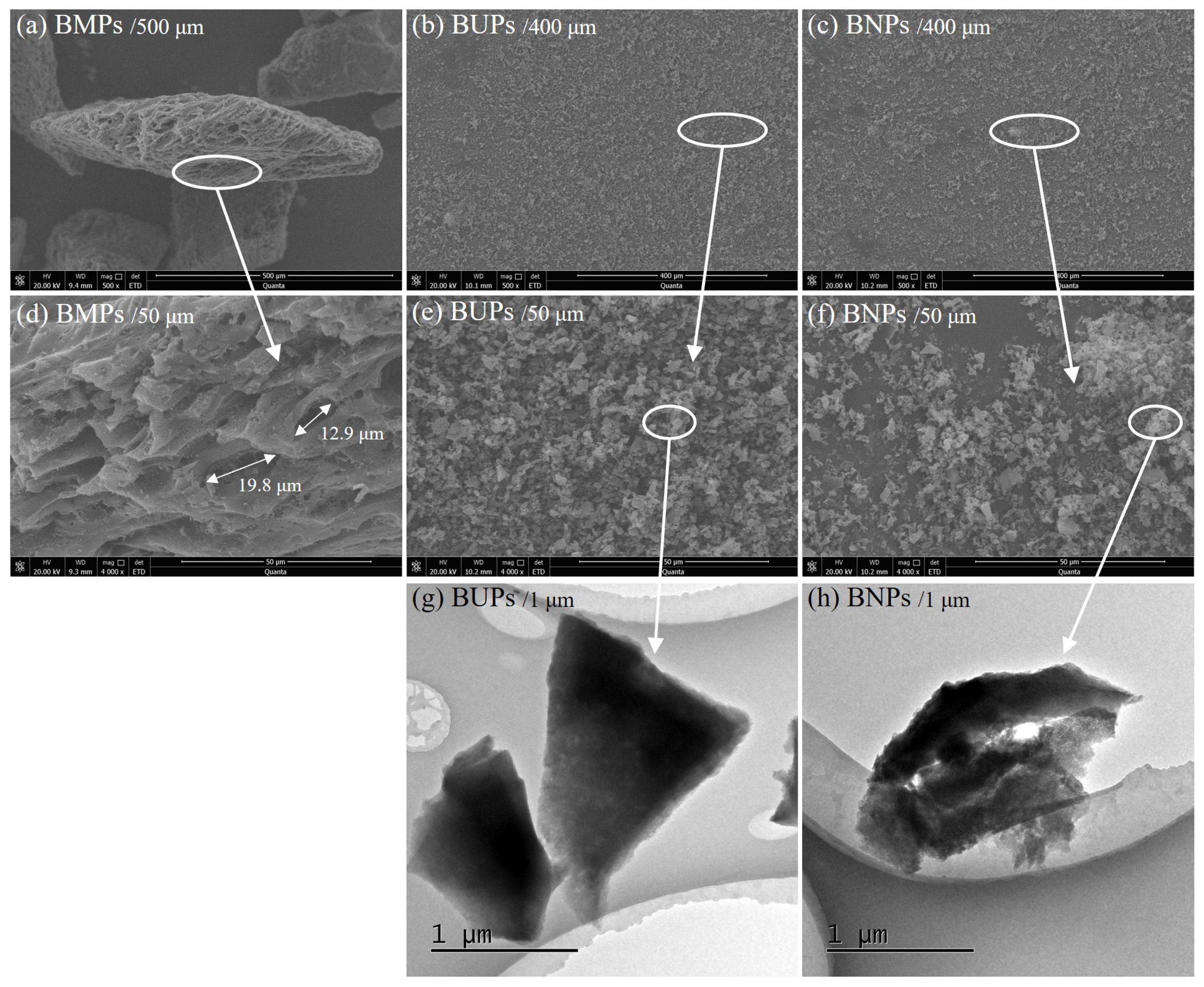
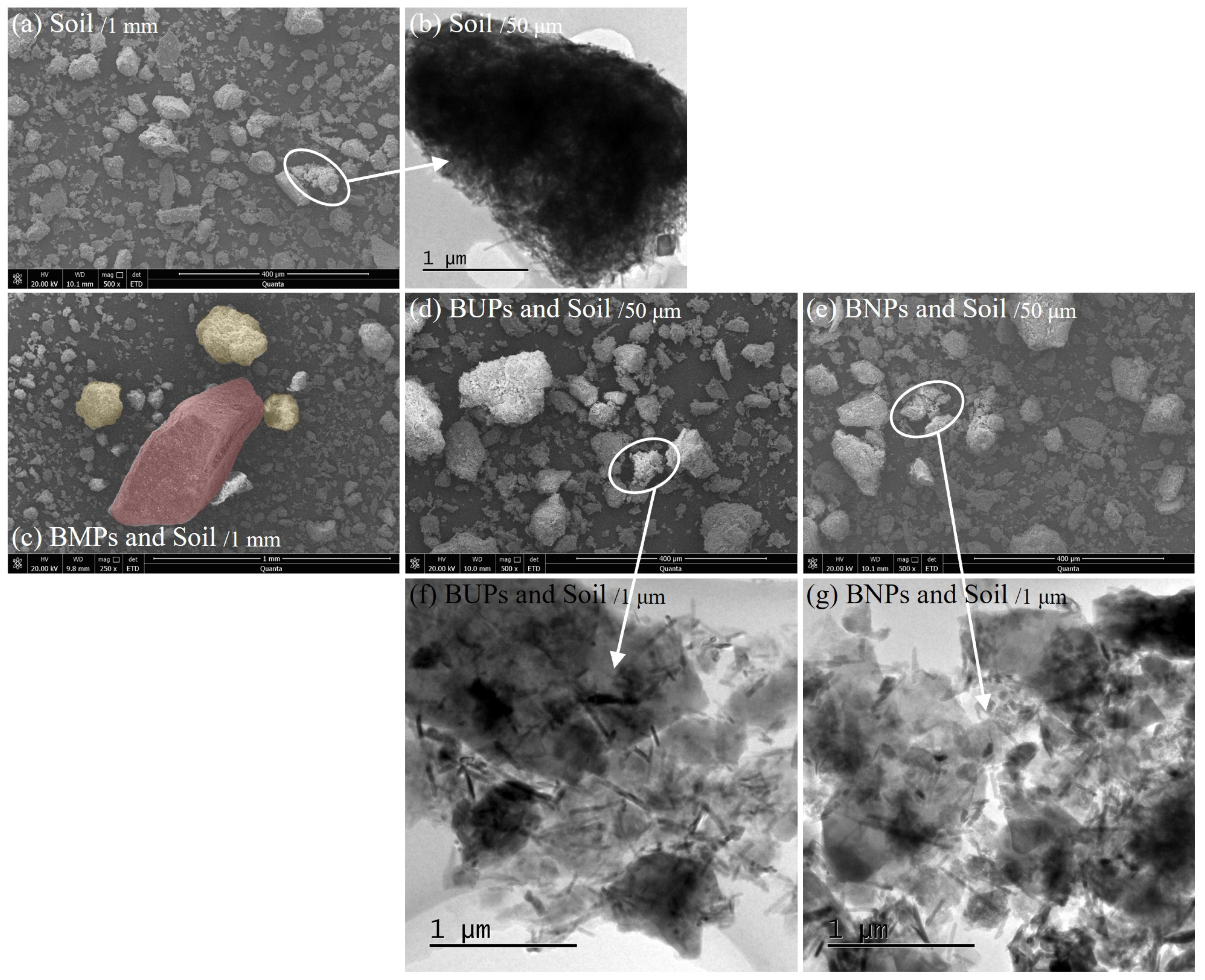

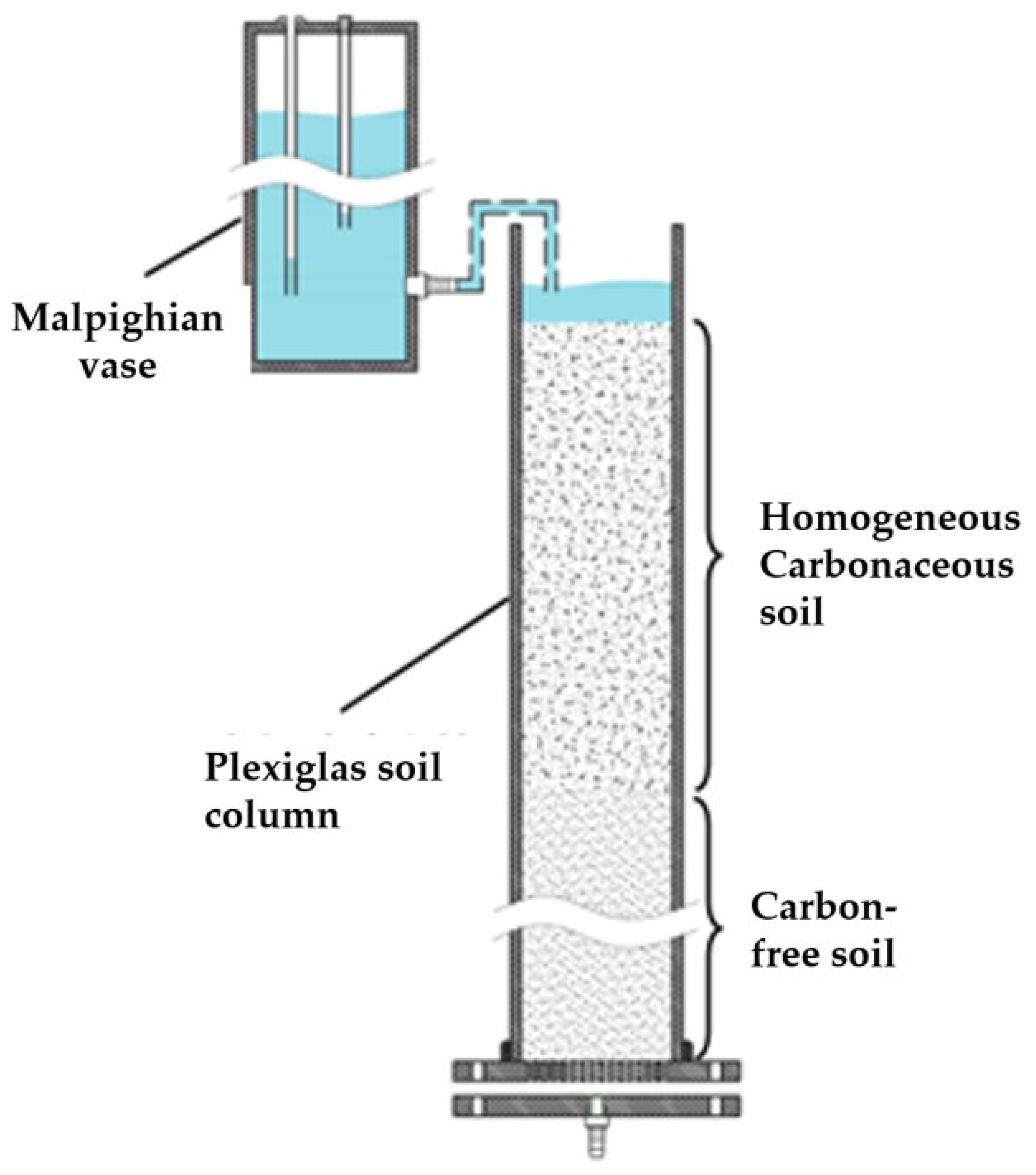
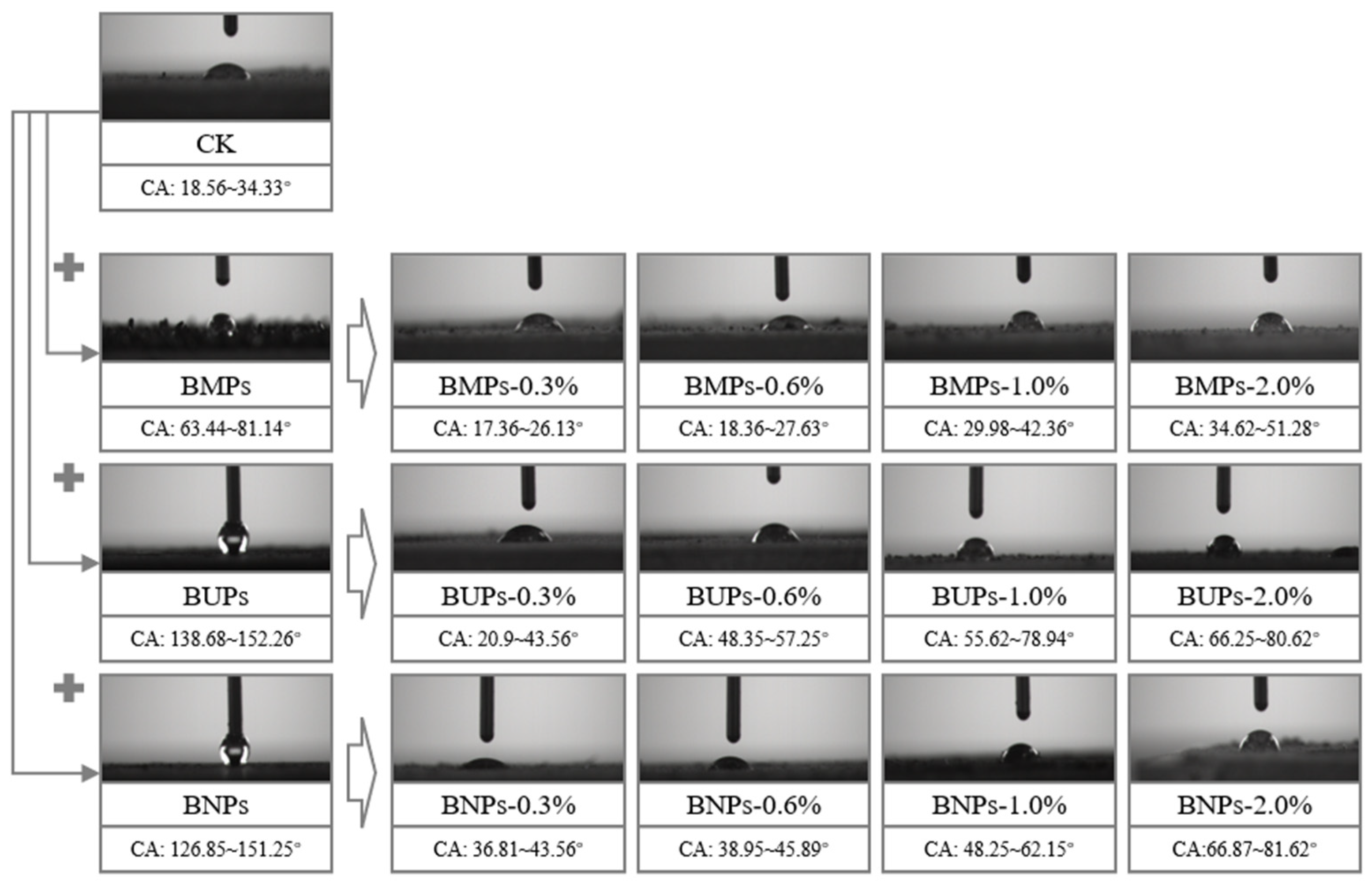
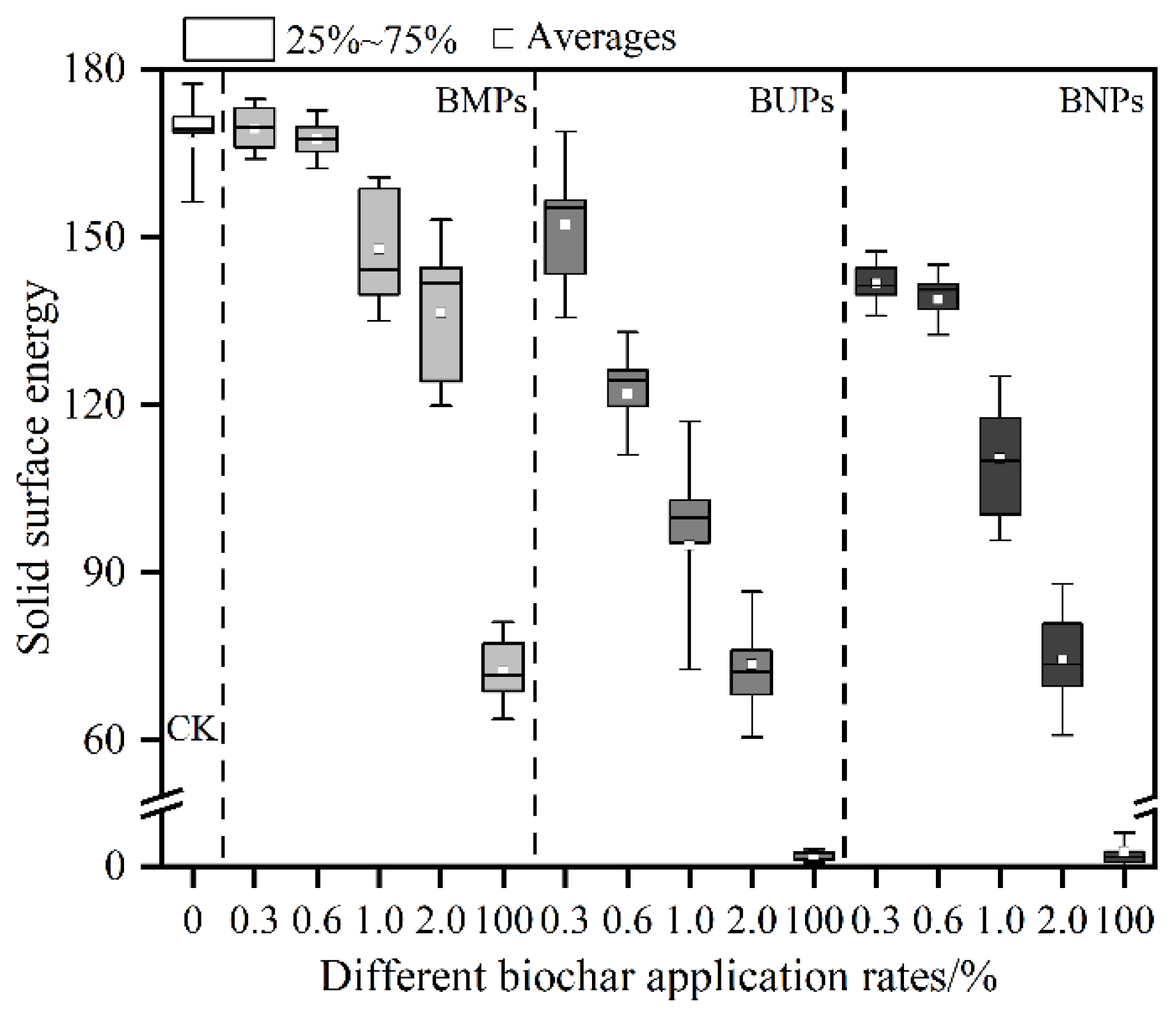
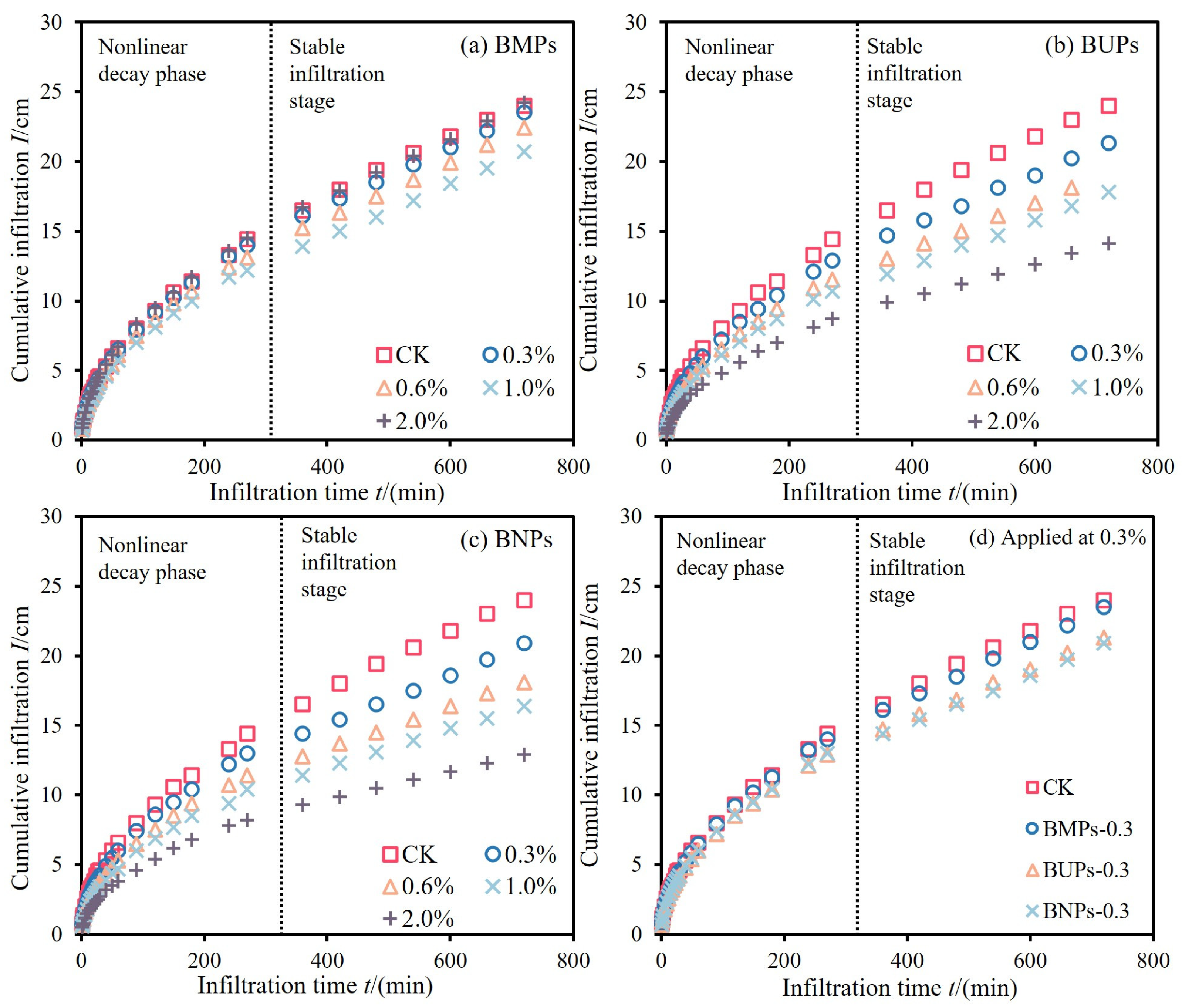
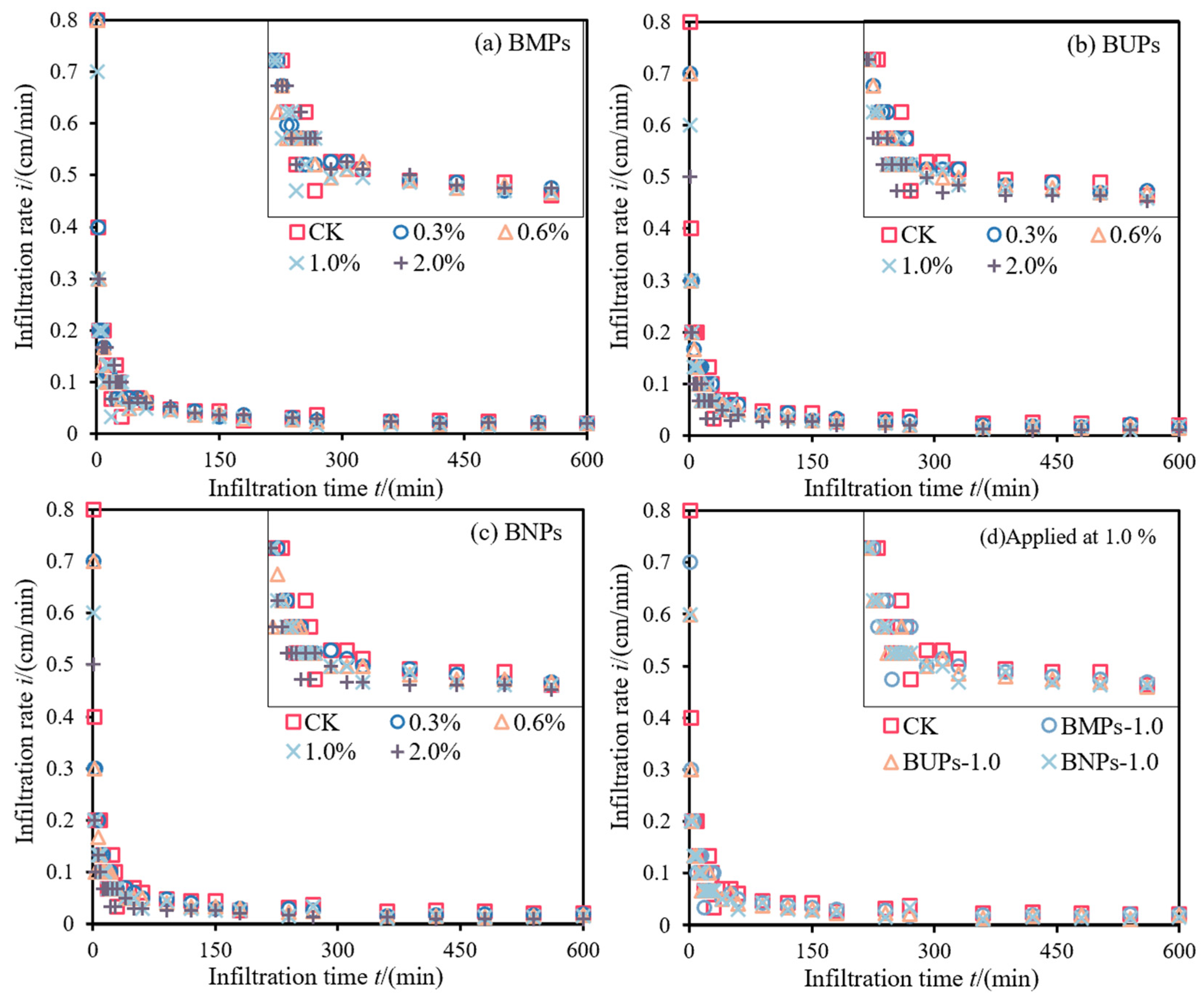
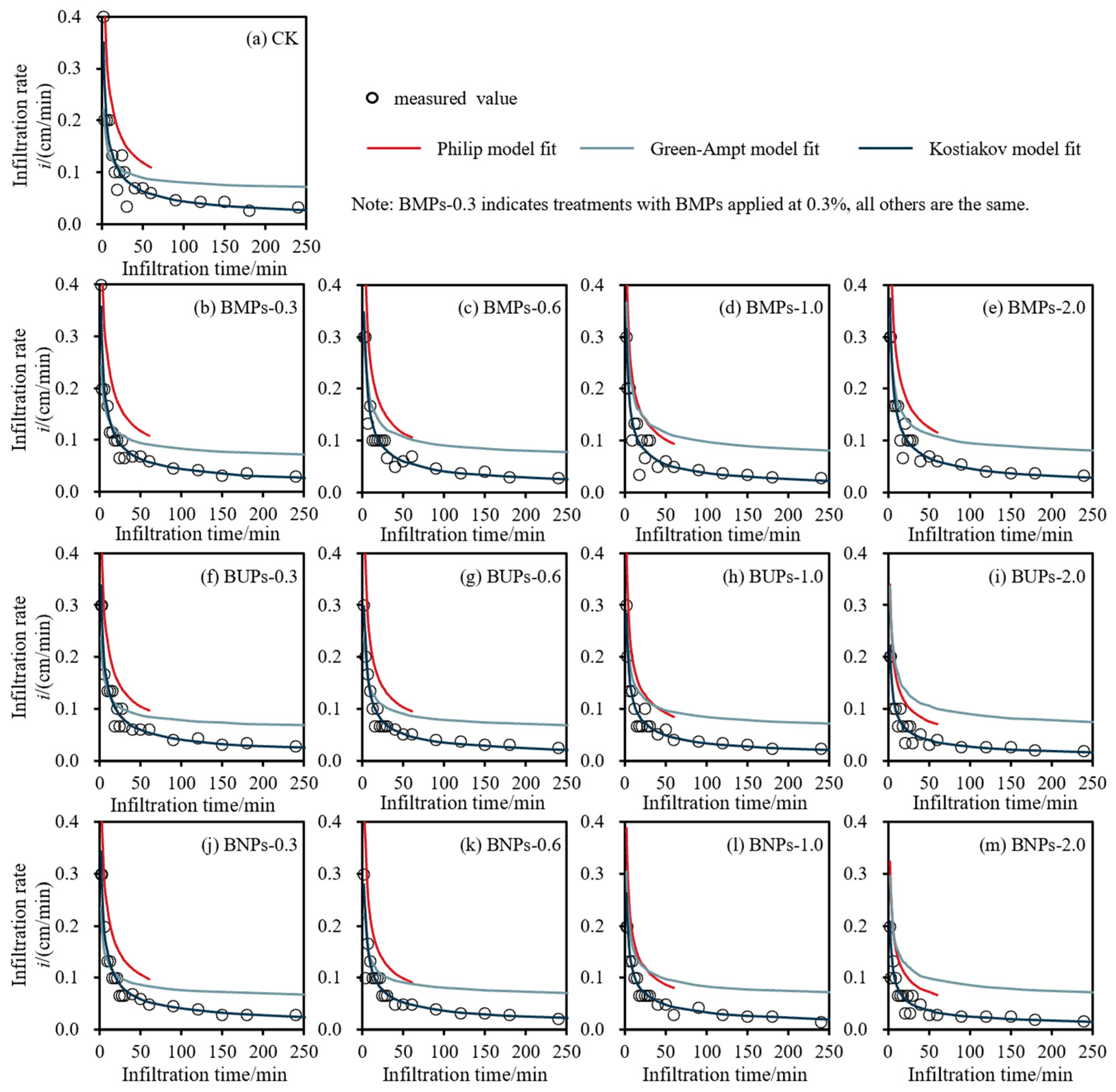


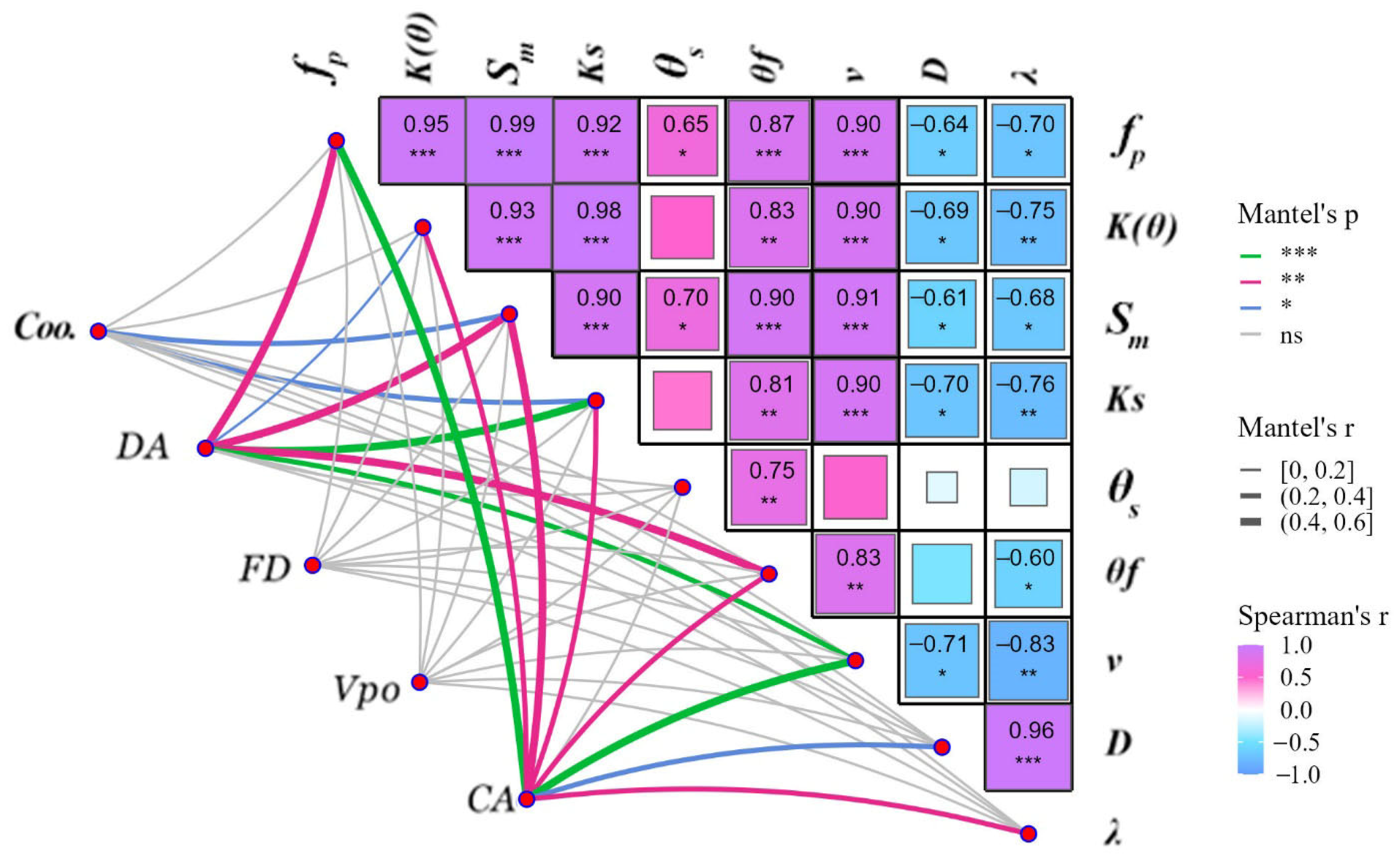
| Biochar Type | Material | Size /nm | Padding /% | Ash /% | pH | Iodine Absorption Value/(mg/g) | BET /(m2/g) |
|---|---|---|---|---|---|---|---|
| BMPs | coconut shell | 1 × 106 | 7.1 | 3.6 | 9.7 | 1010 | 960 |
| BUPs | (1–2) × 103 | 1.5 | 3.1 | 9.8 | 1630 | 1580 | |
| BNPs | (0.4–2) × 102 | 2.1 | 3.3 | 9.8 | 1650 | 1620 |
| Treatment | Rate | Connectivity Coo. | Anisotropy DA | Fractal Dimension FD | Volumetric Porosity Vpo/% |
|---|---|---|---|---|---|
| CK | 2173 ± 261 a | 0.198 ± 0.028 c | 2.495 ± 0.091 a | 1.188 ± 0.021 a | |
| BMPs | 0.3% | 704 ± 106 c | 0.225 ± 0.009 a | 2.223 ± 0.065 d | 0.858 ± 0.018 cd |
| 0.6% | 492 ± 163 d | 0.206 ± 0.063 b | 2.431 ± 0.082 b | 0.900 ± 0.027 c | |
| 1.0% | 226 ± 129 e | 0.189 ± 0.017 d | 2.423 ± 0.035 bc | 0.715 ± 0.008 d | |
| 2.0% | 842 ± 226 b | 0.225 ± 0.052 a | 2.408 ± 0.088 c | 1.035 ± 0.023 b | |
| CK | 2173 ± 261 a | 0.198 ± 0.028 b | 2.495 ± 0.091 a | 1.188 ± 0.021 a | |
| BUPs | 0.3% | 850 ± 151 b | 0.211 ± 0.016 a | 2.488 ± 0.008 b | 1.031 ± 0.016 b |
| 0.6% | 170 ± 72 d | 0.199 ± 0.010 b | 2.304 ± 0.017 d | 0.605 ± 0.023 e | |
| 1.0% | 300 ± 116 c | 0.183 ± 0.007 c | 2.440 ± 0.006 c | 0.872 ± 0.017 c | |
| 2.0% | 133 ± 85 d | 0.182 ± 0.015 c | 2.421 ± 0.011 cd | 0.785 ± 0.011 d | |
| CK | 2173 ± 261 a | 0.198 ± 0.028 c | 2.495 ± 0.091 a | 1.188 ± 0.021 ab | |
| BNPs | 0.3% | 1323 ± 128 b | 0.202 ± 0.012 b | 2.473 ± 0.007 b | 1.203 ± 0.022 a |
| 0.6% | 634 ± 145 c | 0.206 ± 0.014 a | 2.399 ± 0.013 d | 0.963 ± 0.106 b | |
| 1.0% | 369 ± 125 d | 0.182 ± 0.005 d | 2.494 ± 0.042 a | 0.940 ± 0.041 c | |
| 2.0% | 198 ± 117 e | 0.179 ± 0.010 e | 2.451 ± 0.013 c | 0.834 ± 0.033 d |
| Treatment | Rate/% | Ks/(cm/d) | θs/(g/g) | θf/(g/g) |
|---|---|---|---|---|
| BMPs | 0 (CK) | 48.672 ± 0.121 b | 0.381 ± 0.003 d | 0.236 ± 0.003 d |
| 0.3 | 47.544 ± 0.215 c | 0.395 ± 0.004 c | 0.243 ± 0.002 c | |
| 0.6 | 46.920 ± 0.188 d | 0.399 ± 0.004 b | 0.244 ± 0.001 c | |
| 1.0 | 44.592 ± 0.246 e | 0.402 ± 0.003 a | 0.247 ± 0.003 b | |
| 2.0 | 49.344 ± 0.134 a | 0.403 ± 0.005 a | 0.250 ± 0.002 a | |
| BUPs | 0 (CK) | 48.672 ± 0.118 a | 0.381 ± 0.003 d | 0.236 ± 0.001 d |
| 0.3 | 47.640 ± 0.153 b | 0.385 ± 0.002 c | 0.233 ± 0.002 b | |
| 0.6 | 45.288 ± 0.217 c | 0.389 ± 0.003 b | 0.232 ± 0.002 c | |
| 1.0 | 44.136 ± 0.161 d | 0.395 ± 0.003 a | 0.229 ± 0.003 a | |
| 2.0 | 41.928 ± 0.249 e | 0.382 ± 0.002 d | 0.228 ± 0.002 a | |
| BNPs | 0 (CK) | 48.672 ± 0.115 a | 0.381 ± 0.003 d | 0.236 ± 0.002 c |
| 0.3 | 46.896 ± 0.148 b | 0.386 ± 0.004 c | 0.232 ± 0.001 d | |
| 0.6 | 44.640 ± 0.162 c | 0.388 ± 0.003 b | 0.232 ± 0.002 b | |
| 1.0 | 43.584 ± 0.207 d | 0.392 ± 0.003 a | 0.228 ± 0.002 b | |
| 2.0 | 40.680 ± 0.284 e | 0.380 ± 0.004 d | 0.226 ± 0.003 a |
| Treatment | Philip | Green−Ampt | Kostiakov | ||||||
| S | A | R2 | Ks | hf | R2 | a | b | R2 | |
| CK | 1.497 | 0.0121 | 0.946 | 0.057 | 11.811 | 0.949 | 0.505 | −0.529 | 0.951 |
| BMPs-0.3% | 1.496 | 0.0121 | 0.951 | 0.056 | 12.187 | 0.953 | 0.517 | −0.536 | 0.956 |
| BMPs-0.6% | 1.457 | 0.0119 | 0.941 | 0.056 | 12.690 | 0.931 | 0.506 | −0.543 | 0.949 |
| BMPs-1.0% | 1.269 | 0.0117 | 0.937 | 0.055 | 17.538 | 0.939 | 0.459 | −0.544 | 0.948 |
| BMPs-2.0% | 1.595 | 0.0123 | 0.926 | 0.057 | 9.671 | 0.912 | 0.542 | −0.535 | 0.935 |
| CK | 1.497 | 0.0121 | 0.946 | 0.057 | 11.811 | 0.949 | 0.505 | −0.529 | 0.951 |
| BUPs-0.3% | 1.315 | 0.0119 | 0.962 | 0.054 | 17.888 | 0.966 | 0.491 | −0.540 | 0.968 |
| BUPs-0.6% | 1.296 | 0.0118 | 0.949 | 0.052 | 18.200 | 0.945 | 0.434 | −0.544 | 0.954 |
| BUPs-1.0% | 1.136 | 0.0116 | 0.963 | 0.052 | 25.359 | 0.968 | 0.414 | −0.545 | 0.968 |
| BUPs-2.0% | 0.929 | 0.0105 | 0.95 | 0.051 | 37.718 | 0.947 | 0.321 | −0.536 | 0.955 |
| CK | 1.497 | 0.0121 | 0.946 | 0.057 | 11.811 | 0.949 | 0.505 | −0.529 | 0.951 |
| BNPs-0.3% | 1.331 | 0.0119 | 0.968 | 0.053 | 18.098 | 0.971 | 0.500 | −0.547 | 0.973 |
| BNPs-0.6% | 1.228 | 0.0117 | 0.908 | 0.056 | 16.414 | 0.893 | 0.400 | −0.519 | 0.916 |
| BNPs-1.0% | 1.062 | 0.0115 | 0.932 | 0.052 | 26.337 | 0.921 | 0.378 | −0.528 | 0.938 |
| BNPs-2.0% | 0.888 | 0.0092 | 0.92 | 0.051 | 37.197 | 0.909 | 0.297 | −0.535 | 0.928 |
| Treatment | fp /(cm/min) | K(θ) /(cm/min) | Sm /cm |
|---|---|---|---|
| BMPs-0.3% | 0.0217 ± 0.0005 b | 0.0121 ± 0.0001 b | 13.8127 b |
| BMPs-0.6% | 0.0208 ± 0.0009 c | 0.0119 ± 0.0001 c | 13.0140 c |
| BMPs-1.0% | 0.0186 ± 0.0009 d | 0.0117 ± 0.0001 d | 9.8139 d |
| BMPs-2.0% | 0.0224 ± 0.0004 a | 0.0123 ± 0.0002 a | 14.4724 a |
| BUPs-0.3% | 0.0196 ± 0.0003 a | 0.0119 ± 0.0002 a | 10.9131 a |
| BUPs-0.6% | 0.0175 ± 0.0003 b | 0.0118 ± 0.0001 b | 7.6610 b |
| BUPs-1.0% | 0.0165 ± 0.0005 c | 0.0116 ± 0.0002 c | 6.3764 c |
| BUPs-2.0% | 0.0129 ± 0.0007 d | 0.0105 ± 0.0002 d | 2.6032 d |
| BNPs-0.3% | 0.0188 ± 0.0008 a | 0.0119 ± 0.0001 a | 9.6293 a |
| BNPs-0.6% | 0.0159 ± 0.0004 b | 0.0117 ± 0.0001 b | 5.1842 c |
| BNPs-1.0% | 0.0160 ± 0.0003 b | 0.0115 ± 0.0002 c | 5.7778 b |
| BNPs-2.0% | 0.0107 ± 0.0006 c | 0.0092 ± 0.0003 d | 1.2488 d |
| Treatment | v/(cm/min) | D/(cm2/min) | λ/cm | t1/min | t2/min | R2 | SSQ |
|---|---|---|---|---|---|---|---|
| CK | 0.3685 | 0.0015 | 0.0040 | 385.65 | 515.32 | 0.9989 | 0.0002 |
| BMPs-0.3% | 0.3368 | 0.0024 | 0.0071 | 401.23 | 563.33 | 0.9991 | 0.0001 |
| BMPs-0.6% | 0.3217 | 0.0031 | 0.0096 | 412.92 | 581.72 | 0.9987 | 0.0003 |
| BMPs-1.0% | 0.3034 | 0.0049 | 0.0162 | 453.81 | 644.39 | 0.9985 | 0.0003 |
| BMPs-2.0% | 0.3075 | 0.0055 | 0.0179 | 449.72 | 629.58 | 0.9991 | 0.0001 |
| CK | 0.3685 | 0.0015 | 0.0040 | 385.65 | 515.32 | 0.9989 | 0.0002 |
| BUPs-0.3% | 0.3198 | 0.0013 | 0.0041 | 461.39 | 641.17 | 0.9994 | 0.0001 |
| BUPs-0.6% | 0.3036 | 0.0041 | 0.0135 | 513.72 | 705.49 | 0.9991 | 0.0001 |
| BUPs-1.0% | 0.2687 | 0.0048 | 0.0179 | 576.66 | 845.92 | 0.9990 | 0.0002 |
| BUPs-2.0% | 0.2245 | 0.0075 | 0.0334 | 669.23 | 1049.66 | 0.9995 | 0.0001 |
| CK | 0.3685 | 0.0015 | 0.0041 | 385.65 | 515.32 | 0.9989 | 0.0002 |
| BNPs-0.3% | 0.3006 | 0.0023 | 0.0077 | 509.18 | 701.59 | 0.9994 | 0.0001 |
| BNPs-0.6% | 0.2831 | 0.0049 | 0.0173 | 542.34 | 758.92 | 0.9997 | 0.0001 |
| BNPs-1.0% | 0.2694 | 0.0061 | 0.0226 | 596.15 | 838.66 | 0.9996 | 0.0001 |
| BNPs-2.0% | 0.2078 | 0.0083 | 0.0399 | 694.16 | 1119.47 | 0.9993 | 0.0001 |
Disclaimer/Publisher’s Note: The statements, opinions and data contained in all publications are solely those of the individual author(s) and contributor(s) and not of MDPI and/or the editor(s). MDPI and/or the editor(s) disclaim responsibility for any injury to people or property resulting from any ideas, methods, instructions or products referred to in the content. |
© 2025 by the authors. Licensee MDPI, Basel, Switzerland. This article is an open access article distributed under the terms and conditions of the Creative Commons Attribution (CC BY) license (https://creativecommons.org/licenses/by/4.0/).
Share and Cite
Li, G.; Chen, Y.; Chen, X.; Zhou, B.; Duan, M.; Zhu, H.; Shao, G. Structural Heterogeneity of Biochar Modulates’ Soil Hydraulic Properties and Nutrient Migration. Agronomy 2025, 15, 1830. https://doi.org/10.3390/agronomy15081830
Li G, Chen Y, Chen X, Zhou B, Duan M, Zhu H, Shao G. Structural Heterogeneity of Biochar Modulates’ Soil Hydraulic Properties and Nutrient Migration. Agronomy. 2025; 15(8):1830. https://doi.org/10.3390/agronomy15081830
Chicago/Turabian StyleLi, Guohui, Yayong Chen, Xiaopeng Chen, Beibei Zhou, Manli Duan, Hongyan Zhu, and Guomin Shao. 2025. "Structural Heterogeneity of Biochar Modulates’ Soil Hydraulic Properties and Nutrient Migration" Agronomy 15, no. 8: 1830. https://doi.org/10.3390/agronomy15081830
APA StyleLi, G., Chen, Y., Chen, X., Zhou, B., Duan, M., Zhu, H., & Shao, G. (2025). Structural Heterogeneity of Biochar Modulates’ Soil Hydraulic Properties and Nutrient Migration. Agronomy, 15(8), 1830. https://doi.org/10.3390/agronomy15081830






